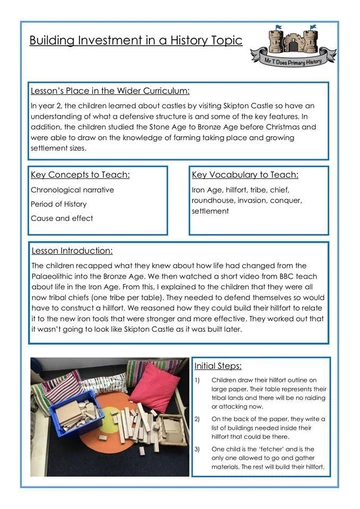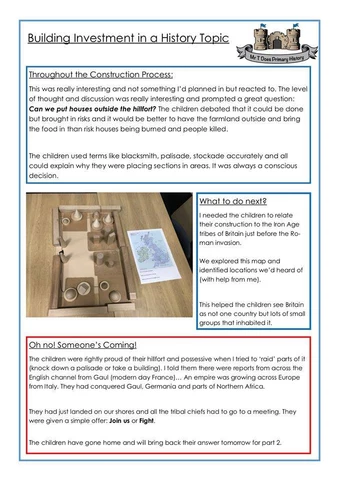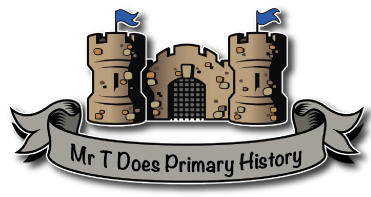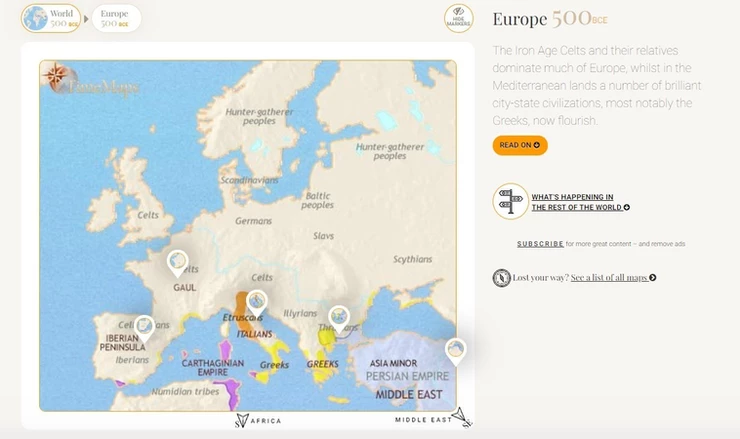Context:
This topic is taught to my Year 3 class and is the second history topic of the year, which follows on from the Stone Age to Iron Age topic that I wrote a blog about before Christmas. In English, we used the Leopard in the Golden Cage by Julia Edwards as it is set in Roman Britain around Fishbourne Palace and is a great narrative with some wonderfully accurate details.
Connecting the Historical Narrative:
I deliberately stressed the concept of narrative in British history to help children understand the fact that the British history we teach is a narrative using the ideas of Ian Dawson. This is a summary of the lesson below:


I’ve begun to term this kind of lesson a bridging lesson where the principle is to ensure children understand how history crosses from the Iron Age into the Roman period.
Sequence of Lessons:
1) Bridging the chronology of British history and reinforce periodisation and duration that was taught in the previous unit of work.
2) Celtic reaction to the invasion and the consequences of those choices using Boudicca and Cartimandua as key individuals.
3) Roman achievements (roads, towns and sanitation in particular) using the same criteria for significance each time and evidence gathering systems to allow comparisons to be made between them.
4) A depth study on York as a significant settlement in Roman Britain.
5) The wider Roman Empire including how it spread, contracted etc and a way for children to understand the local, national and world picture of history at this time. Timemaps and this video really helped children understand the scale of change over time – I narrated key changes and reinforced the use of the colours as to the changing face of the Empire.
Key Knowledge and Concepts:
The best place to look for the key knowledge is the overall curriculum statement from the NC 2014. The statutory statement must be the driving force behind the curriculum and the statements in the box below are for guidance only.
Over this topic, the key knowledge children will be coming away with is:
1) The narrative of British history and how this topic builds on what they know already.
2) The concept of migration of people as an invasion compared with the nomadic lifestyle in prehistory.
3) How the Romans changed and ‘improved’ Britain including the legacy that we can still see today.
4) The expansion of the Roman Empire and that it included multiple modern countries then the contraction.
Concepts being covered have been broken into two separate groups: Disciplinary Concepts and Themes which are used to link topics together.
Disciplinary Concepts:
Enquiry Approach – the learning focuses on how the Romans changed Britain and the legacy that we can see today.
Cause and Consequence – how the different Celtic tribes reacted to Roman invasion and the consequences of those choices.
Significance – which of the Roman achievements in Britain had the most significant impact on people at the time.
Evidence – throughout the topic, the children use a range of sources to learn from and combine the findings including archaeology, primary source material from Tacitus, and a range of secondary sources.
Themes:
Migration and Movement of People – this is a comparison between the nomadic life of people in the Palaeolithic and Mesolithic and what an invasion is. The children also began to consider aspects of life such as trade.
Culture – as part of the depth study into Roman York, children learned about the alleged gladiator graveyard and bathhouse mentioned in the class text.
These are my ideas for the teaching of the Romans and is by no means the only option! Remember, there is no right and wrong answer to this topic – it’s important to deliberately stress concepts and vocabulary so ensure that what is taught is thought through as to how it meets with the aim of the overall enquiry.
I’d love to know your thoughts!

